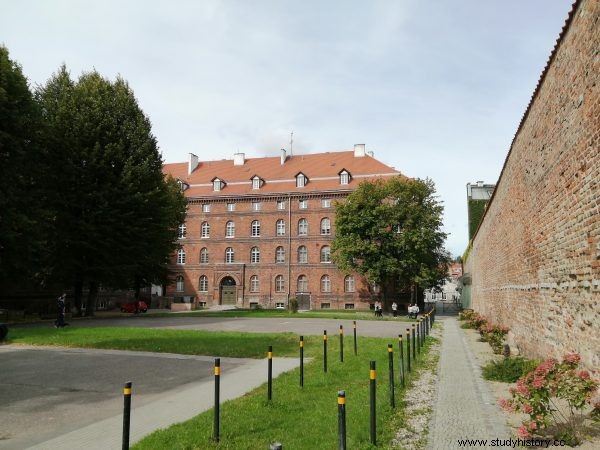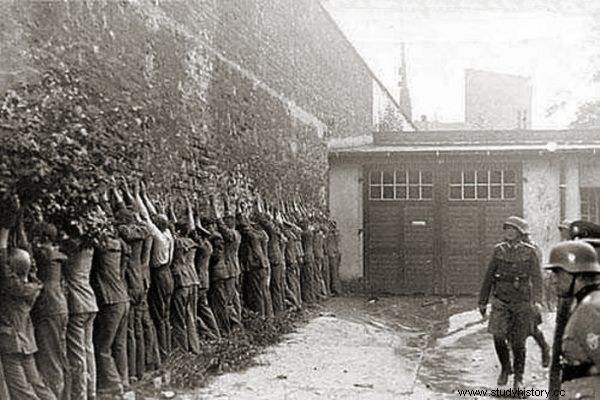They were prepared to defend themselves, but they did not know that the attack would come so quickly and would be so brutal. The Germans burned them alive, they fired despite the white flags. Today, the fingers imprinted on the wall are a symbol of the martyrdom of the defenders of the Polish Post Office in Gdańsk. You can see the hands of a child among them - this is 10-year-old Erwinka ...
The attack on Westerplatte marked the beginning of a six-year war. But the heroic struggle was not only there. When the battleship Schleswig-Holstein was shelling the peninsula, 55 postal workers in the building of the Polish Post Office in Gdańsk also took the most important test of their lives. They were to hold the post for 6 hours - until the arrival of Polish troops. However, help never came.
Among the defenders was a little girl, Erwinka Barzychowska. She was an orphan taken in by the Pipka couple - Jan was a caretaker and together with his wife Małgorzata, he rented an apartment in the post office. Erwinka should not have been there then. But she had nowhere to go. Her only family were Jan and Małgorzata, who decided to fight.
"Danzig ist Deutsch"
As early as 1932, anti-Polish moods in the Free City of Gdańsk grew stronger. The existence of institutions such as the post office only increased the reluctance of the German inhabitants. After all, Poles constituted only about 10% of the population, and the official language was German. The words "Danzig ist Deutsch" were printed on postcards and stamps.
When Adolf Hitler came to power, things got even worse. The campaign began - incl. on postal workers and employees of the facility. Acts of aggression against the postmen were the order of the day. This is how Piotr Derdej described it in the book "Westerplatte-Oksywie-Hel":
Postmen were attacked, their bags with letters cut open, beaten and called names "Polish pigs" and "strayers". Polish mailboxes were damaged many times, covered with tar, etc. with preparations.
Of course, every time the police from Gdańsk, which would normally pick on prostitutes on the street, were strangely sluggish and helpless in such cases. Each time the perpetrators of attacks on Polish officials in Gdańsk managed to escape unnoticed, and the police claimed that the injured Pole owed himself to himself , because with the use of a Polish uniform he provokes the wounded feelings of the subtle inhabitants of Gdańsk, who have the right not to tolerate "foreign occupiers" at home.
"I was awakened by a cannon salvo and the fire of machine guns"
Accompanied by chants of Nazi formations, which marched in increasing numbers along the streets of Gdańsk, the Polish authorities decided to prepare for a possible attack. From then on, the building was to be a refuge for Poles. Konrad Guderski, pseudonym "Konrad", a reserve officer who was transferred to Gdańsk in July 1939 as a postal clerk.
The Third Reich was also getting ready to fight. Hitler's plan to attack Poland envisaged a massive attack on the most important points of resistance, but the Polish Post in Gdańsk was not a strategic place. Why, then, was she the target of an attack? In a city dominated by Germans, it was primarily symbolic - everything Polish had to be destroyed.

The courtyard of the Polish post office with a visible edifice and a wall.
The post office could (and did) serve as a defense point, but it was not a fortress. For this reason, the Germans sent paramilitary and police units to the assault - the Gdańsk Police and the local SS formations, headed by, among others Wilii Bethke, who had the idea of setting fire to the facility in his head, and Alfred Heinrich. The unexpected attack was like a bucket of cold water for the postmen. Sleeping workers were roused from sleep by a powerful explosion and hissing balls falling into the building like swarms of bees. This is how Augustyn Młyński, who managed to escape after the capitulation, reported it:
On September 1 at 4:45 am I was awakened by a cannon salvo and a fire from machine guns. Almost simultaneously, the alarm bell rang, which was called by Szulc, who was on duty. I ran to the weapons warehouse to assist in the distribution of weapons according to a previously agreed plan. Konrad and Flisykowski were already there. An assistant, Binnebesel, who was on night duty at the headquarters, also came and announced that the telephone lines had been interrupted and that we were thus deprived of communication .
The plan to get the mail seemed simple. Two assault groups were to attack the courtyard's entrances to the building at the same time. The attackers made their way using explosives. Did they suspect that the postmen would be armed? Certainly yes, but they did not expect such stiff resistance.
People were choking and burning alive
The plan of the Germans failed because the Polish defense successfully repelled the attack with bursts of machine guns and grenades. At the same time, the parcel department was attacked. The enemies got into the room. The Poles miraculously managed to hold back the attack. Along with Franciszek Klinkosz and August Młyński, weapons from the warehouse were issued by the commander of the defense, Konrad Guderski. He was hit and died on the spot - since then the defense was commanded by Alfons Flisykowski.
The Germans deceitfully tried to gain an advantage. The post office building was adjacent to the building of the German employment office. Through holes in the wall, the attackers tried to get inside the post office. The Poles, however, realized what was happening and immediately set off to stop them . It worked.
After ten hard hours of fighting, the German command announced a two-hour break. The enemies encouraged exhausted Poles to surrender, but were refused. So they brought a 105 mm howitzer, which at 17 began another assault.

Postmen after surrender on 1/09/1939
The defenders' situation became more and more dramatic. There was a shortage of ammunition, there was not enough water, and dust and dirt made it impossible to breathe normally. It was decided to go down to the cellars to continue the defense there. Meanwhile, the frustration of the attackers grew. They wanted to announce as soon as possible that Gdańsk was under control.
Around At 18, motor pumps were brought to the post office, with the help of which gasoline was poured inside. Then she was set on fire with flamethrowers. There was no question of defense. People were choking and burning alive. Capitulation became inevitable.
The youngest defender of the Gdańsk Post Office
Director Jan Michoń was the first to leave the burning building. He appeared in the doorway with a white flag, but was immediately shot. Right behind him appeared the head of the post office, Józef Wąsik, who was burned with a flame thrower.
Then 10-year-old Erwinka came out of the basement with her foster parents. The marriage was badly burned - Małgorzata was blinded, and Jan's skull was visible. The girl was also hurt. According to some sources, the Germans snatched the child from among the capitulators, poured gasoline over him and set him on fire. Erwinka ran around the courtyard, burning until she passed out. However, not everyone confirms this version of events. One thing is certain - the youngest defender of Poczta Gdańska died seven weeks later in the hospital.
The Germans placed the surviving postmen by the wall with their hands up. After the war, the wall was turned into a monument. Fingers were imprinted in specially prepared bricks, more or less at the height on which the defenders rested their hands. One print is particularly noticeable - at the very end of the yard, by a wild bush, much lower than the others. This is a child's hand to commemorate Erwinka.

The grave of Erwinka Barzychowska
Contrary to popular belief, the execution was not carried out by the wall. In fact, the prisoners were transported to the Victoria-Schule school building, where they were held until the field trial, which took place on September 8-10, 1939. 38 postmen were tried then. They were all sentenced to death. The sentence was carried out on October 5 at a police training ground in today's Gdańsk Zaspa. They were also buried there.
On August 28, 1991, the mass grave was accidentally discovered by workers carrying out earthworks on the construction of the bank's garages in the Zaspa estate. They also found personal items - glasses, wedding rings, etc. The remains were transferred to the nearby Cemetery for the Victims of Hitlerism. There is also the tomb of little Erwinka, where people leave candles and stuffed toys to this day ...
